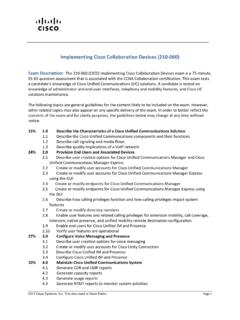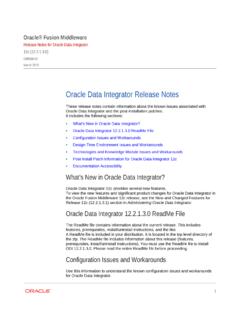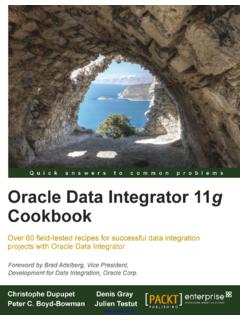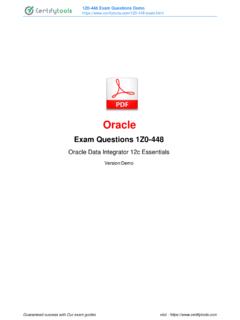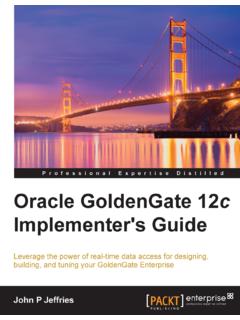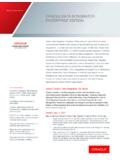Transcription of Oracle Data Integrator 12c: Integration and Administration
1 Oracle University |Contact Us: Local: 1800 103 4775 Intl: +91 80 67863102 Oracle data Integrator 12c: Integration and AdministrationDuration:5 DaysWhat you will learnOracle data Integrator is a comprehensive data Integration platform that covers all data Integration requirements fromhigh-volume, high-performance batch loads, to event-driven Integration processes and SOA-enabled data data Integrator 's Extract, Load, Transform (E-LT) architecture leverages disparate RDBMS engines to processand transform the data - the approach that optimizes performance, scalability and lowers overall solution To:Use Oracle data Integrator to perform transformation of data among various ODI mappings, procedures, and packages to perform ELT data ODI resources and set up security with data Integration and transformation among various the ODI graphical interface to define procedures, packages, and ELT up and maintain a secure, multi-user ODI changed data capture with ODI Web services and perform Integration of ODI with SOA.
2 Benefits to YouTaking this course will teach you how to improve performance and reduce Integration costs across your organization'sheterogeneous systems. You'll be able to centralize data across databases using your new skills to perform dataintegration, design ODI Mappings, and set up ODI security. In addition, Oracle data Integrator can interact with thevarious tools of the Hadoop ecosystem (such as Hive, Hbase, HDFS, Oozie, etc), allowing administrators and datascientists to farm out map-reduce operations from established relational databases to Hadoop. They can also read backinto the relational world the results of complex Big data analysis for further High-Performance Movement and TransformationExpert Oracle University instructors will teach you how to use Oracle data Integrator (ODI) 12c to implementhigh-performance movement and transformation of data among various platforms.
3 This course covers using ODIgraphical user interfaces that enable users to access different ODI components and resources that form RepositoriesUsing the graphical interfaces, you'll develop the knowledge to create and manage ODI repositories, which storeconfiguration information about the IT infrastructure, the metadata for all applications, projects, models and other 2013, Oracle . All rights 1 ODI Topology, Models, Mappings, and Other ObjectsFurthermore, you'll develop the ability to create the ODI Topology, organize ODI models and design ODI Mappings,procedures, packages and other objects. This course is based on Oracle data Integrator 12c ( ).
4 Please NoteThe latest release of Oracle data Integrator supports storing ODI artifacts into source code management systems (suchas Subversion.) This course teaches you how to integrate ODI with AnalystsData ModelersData ScientistData Warehouse AdministratorDatabase AdministratorsSOA ArchitectTechnical ConsultantRelated TrainingRequired PrerequisitesBasic knowledge of ELT data processingCourse ObjectivesAdminister ODI resources and setup security with ODIA pply ODI Topology concepts for data integrationDescribe ODI Model conceptsDescribe architecture of Oracle data Integrator 12cDesign ODI Mappings, Procedures, Packages, and Load Plans to perform ELT data transformationsExplore, audit data .
5 And enforce data quality with ODII mplement Changed data Capture with ODII ntegrate ODI with Version Control Systems (Subversion)Extend ODI to include the Big data Hadoop ecosystemCopyright 2013, Oracle . All rights 2 Course TopicsIntroductionIdentifying the Course UnitsWhy Oracle data Integrator ?Overview of ODI ArchitectureOverview of ODI ComponentsAbout Graphical ModulesTypes of ODI AgentsOverview of Oracle data Integrator RepositoriesAdministering ODI Repositories and AgentsAdministrating the ODI RepositoriesCreating Repository Storage SpacesCreating and Connecting to the Master RepositoryCreating and Connecting to the Work RepositoryCreating a Wallet to Securely Store CredentialsManaging ODI AgentsCreating a Physical AgentLaunching a Listener.
6 Scheduler and Web AgentODI Topology ConceptsOverview of ODI TopologyAbout data Servers and Physical SchemasDefining the Physical ArchitectureDefining the Logical ArchitectureMapping Logical and Physical ResourcesDefining AgentsDefining a TopologyPlanning the TopologyDescribing the Physical and Logical ArchitectureOverview of Topology NavigatorCreating Physical ArchitectureCreating a data ServerTesting a data Server ConnectionCreating a Physical SchemaCreating Logical ArchitectureOverview of Logical Architecture and Context ViewsLinking the Logical and Physical ArchitectureSetting Up a New ODI ProjectOverview of ODI ProjectsCreating a New ProjectCreating and Maintaining FoldersOrganizing Projects and FoldersUnderstanding Knowledge ModulesExchanging ODI Objects and Sharing Global ObjectsExporting and Importing ObjectsCreating and Labeling with MarkersOracle data Integrator Model ConceptsCopyright 2013, Oracle .
7 All rights 3 What is a Model?Understanding Metadata in ODIU nderstanding Reverse EngineeringCreating ModelsOrganizing ModelsCreating data storesConfiguring Constraints in ODIC reating Keys and ReferencesOrganizing ODI Models and Creating data storesWhat is a Mapping?Business Rules for MappingsCreating a Basic MappingWhat is a Join?What is a Filter?What is a Constraint?What is a Staging Area?ODI Mapping ConceptsWhat is a Mapping?Business Rules for MappingWhat is a Mapping, a Filter, a Join?Overview of Integration ProcessWhat is a Staging Area?Execution LocationMapping with Knowledge Modules (KM)Creating an Intermediate MappingDesigning MappingsDesigning a MappingMultiple Source data storesCreating JoinsFiltering DataDisabling TransformationsOverview of the FlowSpecifying the Staging AreaSelecting Knowledge ModulesMapping: Monitoring and DebuggingMonitoring MappingsCreating Objects with OperatorViewing Sessions and TasksHow to Monitor Execution of a MappingHow to Troubleshoot a SessionKeys to Reviewing the Generated CodeWorking with ErrorsTips for Preventing ErrorsDesigning Mappings.
8 Advanced Topics 1 Mapping with Business RulesOverview of Business Rule ElementsCreating and Tracking VariablesCopyright 2013, Oracle . All rights 4 Creating User FunctionsMapping Substitution MethodsModifying a KMShowing Variable Values in LogCustomizing Reverse Engineering Using RKMD esigning Mappings: Advanced Topics 2 Using Partitioning in a MappingReusable MappingsDerived Select (Subselect) for Reusable MappingsUsing User FunctionsCreating a User FunctionUsing Substitution MethodsDeveloping Your Own Knowledge ModuleCreating and Running ODI proceduresWhat is a Procedure?Examples of ProceduresCreating ProceduresAdding CommandsAdding OptionsRunning a ProcedureViewing Results with OperatorUsing ODI PackagesWhat is a Package?
9 Creating a PackageExecuting a PackageCreating Advanced PackagesError HandlingControlling an Execution PathCreating a LoopUsing the Advanced tabStep-by-Step DebuggerStarting a Session in Debug modeSpecifying Debug PropertiesControl Execution FlowScreen Step NumberingManaging ODI Scenarios and VersionsWhat is a Scenario?Managing Scenarios with Load PlansPreparing Scenarios for DeploymentAutomating Scenario ManagementScheduling the ODI ScenarioOverview of ODI version managementHandling concurrent changesUsing Load PlansWhat Are Load Plans?Load Plan EditorCopyright 2013, Oracle . All rights 5 Load Plan StepsDefining the Restart BehaviorBenefits of Using Load PlansHandling Failed Load PlansEnforcing data Quality and Auditing data with ODIWhy data Quality?
10 When to Enforce data Quality? data Quality in Source ApplicationsData Quality Control in the Integration ProcessData Quality in the Target ApplicationsEnforcing data QualityExploring Your DataAuditing data QualityWorking with Changed data CaptureOverview of ODI version managementTechniques of Changed data CaptureChanged data Capture in ODICDC Strategies and InfrastructureCDC ConsistencyCreating Change data Capture (CDC)Viewing data /Changed dataJournalizingAdvanced ODI AdministrationIntroduction to ODI Security NavigatorSecurity Concepts: Overview, Defining Security PoliciesCreating Profiles, Creating Users, Assigning a Profile to a User, Assigning an Authorization by Profile or UserDefining Password Policies, Implementing External AuthenticationGenerating Topology ReportsIntegration of ODI with Enterprise ManagerJava EE Agent and Enterprise Manager Configuration with WebLogic DomainUsing ODI ConsoleIntegrating ODI with SubversionODI: VCS IntegrationODI.




